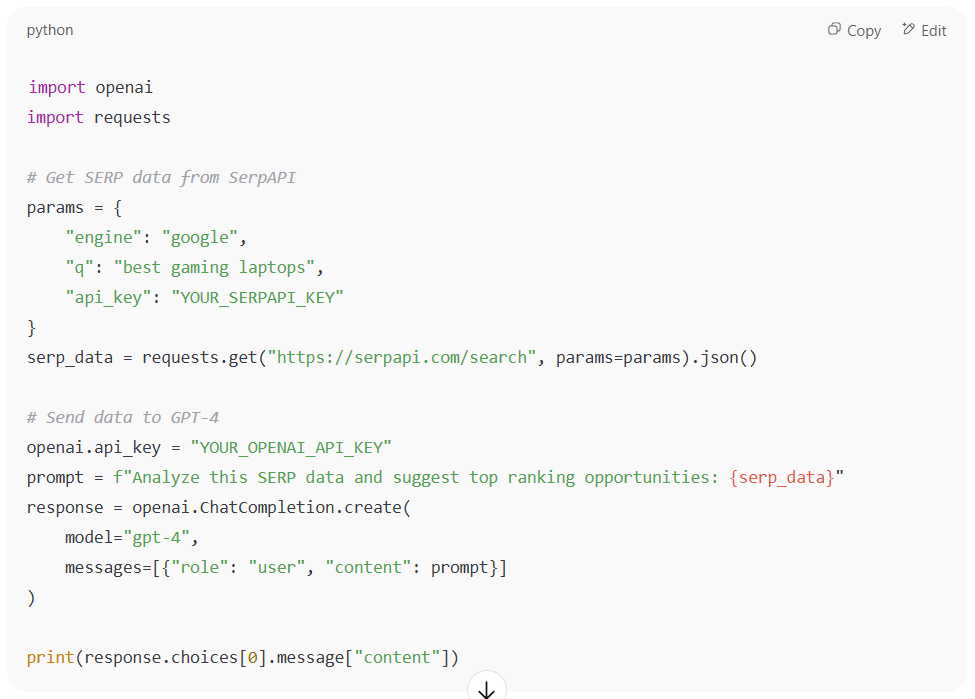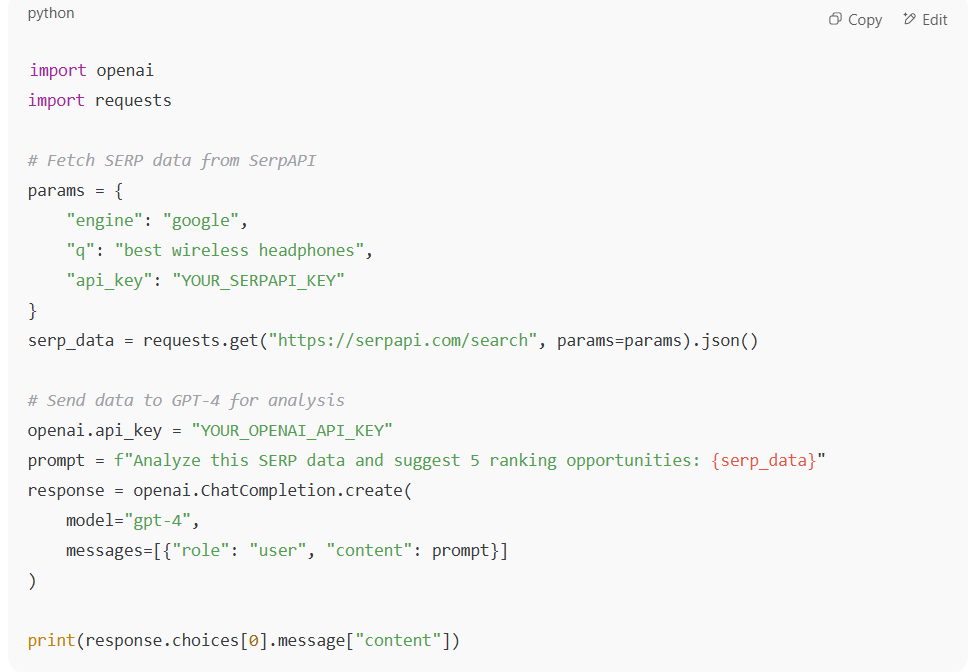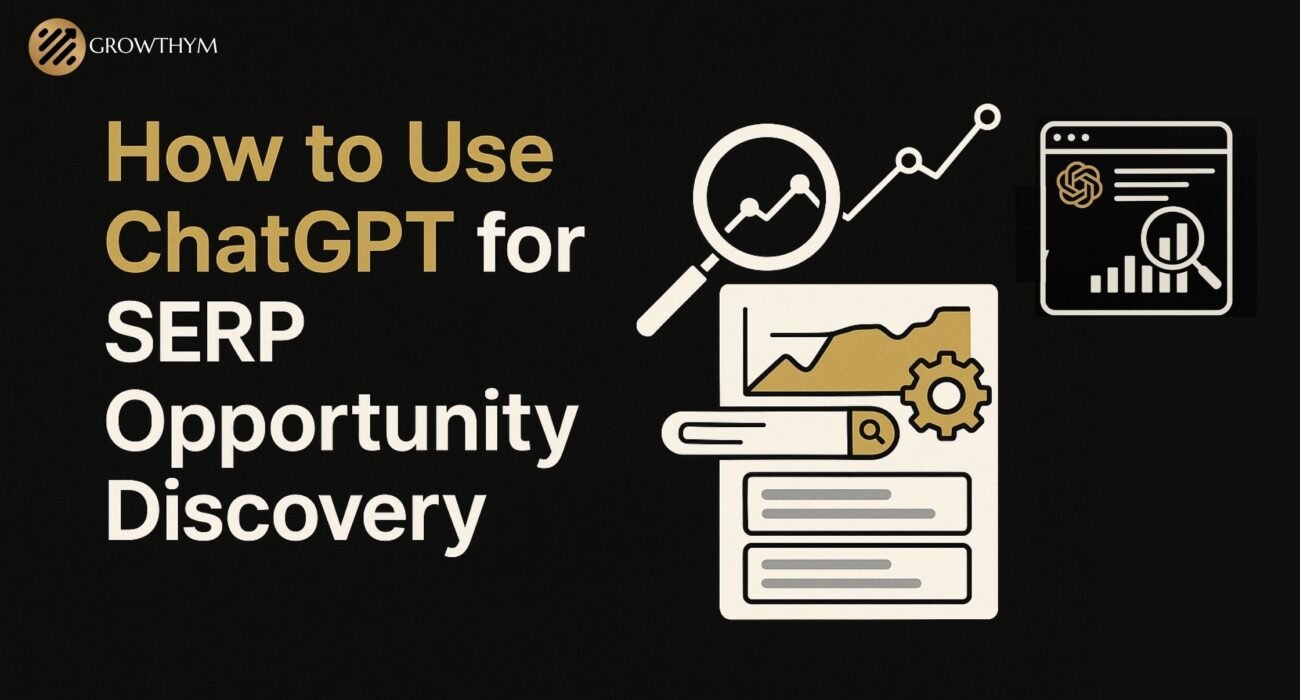Finding the right search opportunities is one of the fastest ways to improve your website traffic and rankings. But in most cases, analysing the Search Engine Results Page (SERP) manually takes a lot of time, and it is easy to miss hidden opportunities.
This is where ChatGPT can make a big difference. It can read SERP data at scale, understand patterns in search intent, and highlight the keywords where your business has a realistic chance to rank. With the right workflow, ChatGPT becomes more than just a writing tool — it becomes a powerful SEO assistant.
In this guide, we will walk through a step-by-step process to use ChatGPT for SERP opportunity discovery. You will learn:
- How to gather the right SERP data.
- How to design prompts that extract actionable insights.
- How to automate the process for regular updates.
- How to connect the results with your SEO strategy.
We will also share real case study examples to show how this approach works in different industries. If you want to understand the wider role of AI in SEO, you can explore our AI SEO Guide for additional strategies.
By the end of this blog, you will have a ready-to-use framework to find SERP opportunities using ChatGPT — and turn them into traffic and revenue growth.
Understanding SERP Opportunity Discovery
SERP opportunity discovery means finding keywords where ranking is realistic and profitable. It helps you focus on terms that can drive high-value traffic. You also learn what searchers want and how competitors meet that need.
Understanding Search Intent and Competition
Search intent shows the reason behind a query. It may be informational, transactional, or navigational. Studying intent helps match your content with what users want. You also need to check how strong your competitors are. A strong domain with many backlinks is harder to outrank.
Types of SERP Opportunities
Some keywords have high search volume but low competition. These are the easiest wins. Featured snippets can bring clicks even without ranking first. Zero-click SERPs show results directly on Google, but they still build brand visibility. Emerging trends and seasonal queries can give early-mover advantages.
Limitations of Traditional Methods
Manual keyword research takes a lot of time. You may miss patterns hidden in large datasets. Traditional methods rely on static data, while SERPs change daily. This makes it easy to lose opportunities if you are slow to act.
Using ChatGPT solves these issues by reading large datasets, finding trends, and suggesting quick actions.
Why Use ChatGPT for SERP Analysis?
ChatGPT can read, understand, and summarise SERP data at scale. It finds patterns humans may miss and suggests keyword opportunities you can act on quickly. By combining speed and context, ChatGPT becomes a strategic SEO tool, not just a content generator.
1. Advanced NLP Capabilities
ChatGPT understands language in context. It goes beyond matching keywords and recognises related phrases and topics. This helps group similar queries and uncover hidden opportunities.
2. Automated Pattern Recognition
It can scan large keyword lists and identify trends instantly. Instead of checking each keyword manually, you get grouped opportunities in seconds.
3. Creative and Strategic Insights
ChatGPT can suggest unique content angles based on SERP layouts. If a SERP shows videos, it may suggest a video-first approach. If it has “People Also Ask,” it can give exact questions to answer.
4. API and Workflow Integration
You can connect ChatGPT with Google Search Console, Ahrefs, or custom scrapers. This creates a flow where SERP data goes directly into ChatGPT for analysis. You save time and get a repeatable process.
Data Gathering for ChatGPT SERP Opportunity Analysis
Data quality decides how well ChatGPT can spot SERP opportunities. Good data gives clear insights, while poor data leads to weak suggestions. The goal is to collect accurate SERP details, prepare them in the right format, and send them to ChatGPT for analysis.
1. Extracting SERP Data
You can pull SERP results using APIs like SerpAPI or DataForSEO. These tools give structured results, making them easier to process.
If you use SEO tools like Ahrefs or Semrush, export keyword lists in CSV format. This ensures you get search volume, difficulty, and competition data together.
2. Data Types to Collect
Gather keywords along with search intent, monthly volume, CPC, and difficulty score.
Include SERP features such as People Also Ask, Top Stories, videos, and local packs.
Save competitor URLs and their title and meta descriptions. This helps ChatGPT compare your site with top-ranking pages.
3. Pre-processing Data for ChatGPT
Clean raw exports by removing duplicates and irrelevant terms.
Check for missing values and fix them before analysis.
Structure the cleaned data in JSON or CSV so ChatGPT can read it easily. Keep column names simple, like “Keyword,” “Volume,” “Difficulty,” and “SERP_Features.”
Well-prepared data allows ChatGPT to give accurate recommendations and reduces the risk of errors.
Prompt Engineering for SERP Opportunity Discovery
Prompt design decides how useful ChatGPT’s output will be. A well-structured prompt directs the model to focus on valuable insights instead of generic answers. In SERP analysis, prompts should guide ChatGPT toward identifying keywords, ranking chances, and the best content approach.
1. Role of Prompt Design
The prompt tells ChatGPT exactly what to do with your SERP data. Clear instructions help the model filter irrelevant terms and focus on keywords with real potential.
2. Prompt Examples
Keyword Gap Analysis Prompt
Analyze the following keywords with their metrics and identify the top 10 where my site could realistically rank in the top 5 within 3 months.
SERP Feature Opportunity Prompt
Given these SERP features for each keyword, suggest content formats that could win them.
Competitive Content Gap Prompt
Identify keyword clusters my competitors rank for but I don’t, and propose angles to outperform them.
These prompts help ChatGPT detect gaps, content ideas, and SERP-specific opportunities.
3. Iterative Prompting
One prompt may not give the full picture. You can refine results with follow-up prompts, known as iterative prompting. For example, after getting keyword suggestions, ask ChatGPT to re-rank them by ROI or competition level. This step-by-step approach increases accuracy.
4. Structuring Output for Actionability
Request ChatGPT to return results in a table format. Include columns like “Keyword,” “Search Volume,” “Difficulty,” “SERP Feature,” and “Priority Score.” Tables make it easier to sort and plan actions in your SEO tools.
By combining precise prompts with clear output formats, you turn ChatGPT into a structured SERP research assistant.
Using ChatGPT to Identify SERP Patterns and Trends
ChatGPT can find patterns in SERP data that humans might overlook. By grouping related queries, spotting trends, and detecting content decay, you can plan faster and smarter SEO actions.
1. Clustering Similar Queries
ChatGPT can group keywords based on intent or topic.
For example, “best running shoes for women” and “top women’s sports shoes” may belong to the same cluster.
Grouping helps you plan content hubs or pillar pages, improving topical authority.
2. Identifying Ranking Opportunities from Trends
Trends move fast, and ranking early gives a big advantage.
You can combine Google Trends data with ChatGPT to summarise which rising keywords match your niche.
For example, if a fitness brand sees “home resistance bands workout” gaining searches, ChatGPT can suggest content ideas before competitors act.
3. Detecting Content Decay and Re-optimization Opportunities
Old content can drop in rankings if competitors publish fresher or better-optimised pages.
By cross-referencing Google Search Console performance drops with ChatGPT’s SERP review, you can spot decayed pages.
If your page on “best budget laptops 2023” is losing clicks, ChatGPT may recommend updating it for 2024 with new models and specs.
Using ChatGPT for patterns and trends ensures you act before opportunities fade or competitors take the lead.
Automating SERP Opportunity Discovery with ChatGPT APIs
Automation saves time and makes SERP analysis consistent. By linking scraping tools, data cleaning scripts, and ChatGPT’s API, you can run opportunity discovery without manual work.
1. Workflow Example
A simple automation flow looks like this:
SERP scraping → Data preprocessing → ChatGPT API call → Output into Google Sheets or Notion.
The scraper collects SERP data. A preprocessing script cleans and formats it. The ChatGPT API analyses the data and sends insights to your reporting tool.
2. Code Snippets (Python)
You can integrate SerpAPI with ChatGPT using Python:

This script fetches SERP data, sends it to ChatGPT, and prints ranking suggestions.
3. Scheduling & Scaling
Use cron jobs or cloud schedulers to run this process weekly or monthly. Regular checks help track changes in SERPs and capture new opportunities quickly.
4. Integration with SEO Dashboards
Connect the final output to Google Data Studio, Notion, or custom dashboards. This creates a live SERP opportunity tracker that updates automatically.
Automating this process ensures you never miss ranking chances and reduces manual analysis time.
Case Study: ChatGPT in Action for SERP Opportunity Discovery
This case study shows how an eCommerce retailer used ChatGPT to find and capture new search opportunities. You can read the full project in our eCommerce retailer case study.
1. Scenario Setup
The client ran an online store selling eco-friendly home products. They wanted to increase organic traffic and win more featured snippets without large ad spend.
2. Process Overview
We started by extracting SERP data for 500 target keywords using SerpAPI and their existing SEO tool exports.
After cleaning the data, we sent it to ChatGPT with prompts to:
- Identify keywords with low competition but good search volume.
- Highlight SERP features worth targeting, like “People Also Ask” and snippets.
- Suggest unique content angles based on competitor weaknesses.
The output was delivered in a table format with priority scores. The SEO team used these insights to create and update content.
3. Results & Insights
Within 90 days, the site gained 35% more organic traffic.
We secured 8 new featured snippets for high-intent queries.
Click-through rates improved on pages that targeted low-competition, high-CTR keywords.
The key takeaway was clear: when ChatGPT processes structured SERP data, it can reveal fast-win opportunities that traditional research often misses.
Limitations and Best Practices
Using ChatGPT for SERP opportunity discovery works well, but it’s not perfect. Knowing its limits helps you get better results.
Limitations
- Depends on Input Quality
If your SERP data is messy or incomplete, ChatGPT will give weak suggestions. Always feed it clean, accurate data.
- May Misread Data (Hallucination)
ChatGPT can sometimes make wrong assumptions about the SERP. It might suggest a keyword as low competition when it’s not.
- Needs Human Validation
AI speeds up analysis, but you must still confirm results with tools like Ahrefs, Semrush, or Google Search Console.
Best Practices
- Cross-Check with SEO Tools
Always verify ChatGPT’s keyword suggestions before taking action. This keeps your strategy grounded in real search data.
- Use Clear and Structured Prompts
Vague prompts confuse ChatGPT. Tell it exactly what you want and in what format.
- Create a Feedback Loop
After testing ChatGPT’s suggestions, update your prompts based on what worked and what didn’t. Over time, this makes the results sharper and more reliable.
By combining ChatGPT’s speed with human expertise, you get a balanced and effective SERP discovery process.
Conclusion
ChatGPT can change how you find and act on SERP opportunities. It reads large sets of SERP data, spots patterns, and suggests keywords you can target right away. When paired with automation, it can keep your keyword research fresh without extra manual work.
The most important factor is balance. ChatGPT can process and summarise faster than any human, but your expertise ensures the suggestions are practical and aligned with business goals. Always verify its findings with SEO tools and real performance data.
Whether you are looking for quick wins, featured snippet opportunities, or trending topics, ChatGPT can become a core part of your SEO workflow. If you want to explore how AI can improve your organic growth, our SEO services show how we combine AI and proven SEO strategies to drive results.
With the right process, prompts, and checks, ChatGPT turns SERP opportunity discovery into a faster, smarter, and more consistent task.
Appendix: Prompt Templates & Code Snippets
This section gives ready-to-use prompts and a sample Python script to help you start quickly.
1. Ready-to-Use Prompts
Keyword Analysis Prompt
“From the following keyword list with search volume, CPC, and difficulty, find the top 15 keywords where ranking in the top 5 is possible within 90 days. Return results in a table format with Priority Score.”
SERP Feature Identification Prompt
“For each keyword and its SERP features, suggest the best content type (article, video, infographic) to win that position. Return the answer in a table format.”
Competitive Gap Analysis Prompt
“Compare my keyword list to the competitors’ ranking keywords. Identify topics they rank for but I don’t. Suggest angles to create better and more engaging content.”
2. Python Code Snippet

This code collects SERP results, sends them to ChatGPT, and prints actionable keyword suggestions.
With these prompts and scripts, you can begin automating SERP opportunity discovery right away.
FAQs: ChatGPT for SERP Opportunity Discovery
Q1. What is SERP opportunity discovery?
SERP opportunity discovery is the process of finding keywords and topics where your website can rank well on Google search results. It includes identifying low-competition keywords, featured snippet targets, and trending topics.
Q2. How can ChatGPT help with SERP opportunity discovery?
ChatGPT can process large SERP datasets, group keywords by search intent, spot content gaps, and suggest content formats. This speeds up keyword research and makes it more accurate.
Q3. What data do I need to give ChatGPT for analysis?
You should provide keywords, search volume, difficulty, CPC, SERP features, and competitor URLs. Structured data in CSV or JSON works best for ChatGPT analysis.
Q4. Can ChatGPT replace traditional SEO tools?
No. ChatGPT works best as a supplement to tools like Ahrefs, Semrush, or Google Search Console. It gives insights faster, but you still need SEO tools for accurate metrics.
Q5. How often should I run SERP opportunity analysis?
For most websites, monthly analysis works well. For fast-moving niches, weekly checks help you stay ahead of competitors and trends.
Q6. Is ChatGPT accurate for keyword ranking predictions?
ChatGPT can make strong predictions based on the data you give, but human validation is always needed to confirm feasibility and avoid false positives.
Q7. Can I automate ChatGPT SERP analysis?
Yes. You can integrate SERP APIs like SerpAPI with ChatGPT and run automated scripts to send results to Google Sheets or SEO dashboards.

